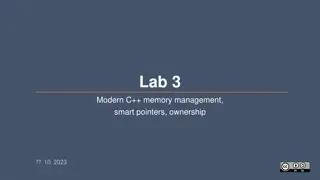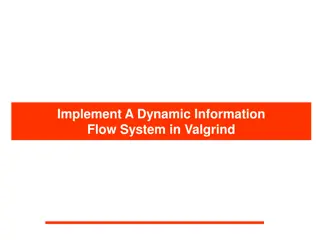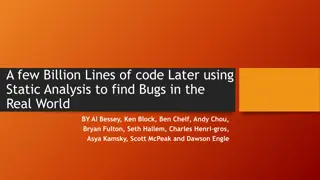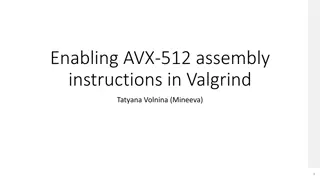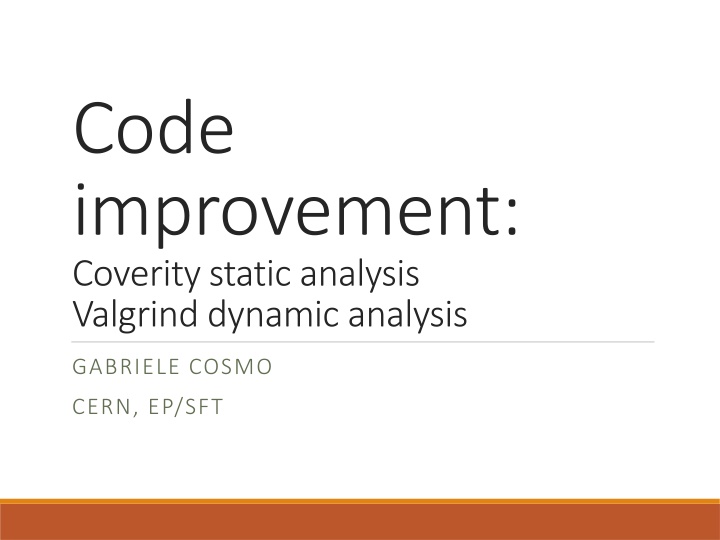
Improving Code Quality with Coverity and Valgrind Analysis
Explore the process of static and dynamic code analysis using tools like Coverity and Valgrind. Learn how to triage defects, manage memory leaks, and enhance code quality through defect classification and resolution. Gain insights into common defect types and best practices for efficient code organization and performance. Discover how to utilize Coverity for in-depth defect analysis and triaging, ensuring a streamlined and effective development process.
Download Presentation

Please find below an Image/Link to download the presentation.
The content on the website is provided AS IS for your information and personal use only. It may not be sold, licensed, or shared on other websites without obtaining consent from the author. If you encounter any issues during the download, it is possible that the publisher has removed the file from their server.
You are allowed to download the files provided on this website for personal or commercial use, subject to the condition that they are used lawfully. All files are the property of their respective owners.
The content on the website is provided AS IS for your information and personal use only. It may not be sold, licensed, or shared on other websites without obtaining consent from the author.
E N D
Presentation Transcript
Code improvement: Coveritystatic analysis Valgrinddynamic analysis GABRIELE COSMO CERN, EP/SFT
Outline Code static analysis with Coverity How to triage defects Current status of Static Code Analysis Code dynamic analysis with Vagrind Run-time errors checks Keeping memory leaks under control 2 14 September 2016 G.COSMO - CODE IMPROVEMENT: COVERITY & VALGRIND
Coverity Static Code Analysis Inspecting only the source code Execution by replacing the compiler Analysis performed on all possible branches of the code Complex and time consuming Identifies defects in the code organizes by type, severity, file/module Results published on Coverity server at CERN https://coverity.cern.ch 3 14 September 2016 G.COSMO - CODE IMPROVEMENT: COVERITY & VALGRIND
Coverity: triaging defects Defects are assigned to responsible (owner) The owner can classify a defect as: Pending / False positive / Intentional / Bug Can assess and specify the severity: Major, Moderate, Minor Can specify an action (performed or to be performed): Fix required, Fix submitted, Modeling required, Ignore According to the action, the defect is marked as triaged Statistics will be updated Defects fixed in the code will automatically disappear from the defects lists, even if never triaged in the tool Defects not fixed will show up again at the next analysis 4 14 September 2016 G.COSMO - CODE IMPROVEMENT: COVERITY & VALGRIND
Coverity: defects types Memory corruption / illegal accesses Double free, out-of-bound accesses, use-after-delete, Resource leaks Non virtual destructor, memory leaks, Uninitialized variables, Unused pointer values, Infinite loops, Missing copy ctors, API usage errors Non restoring ostream format, use of invalid iterator, Control flow issues Unused/dead code, invalid iterator comparisons, Incorrect expressions Self-assignment, misuse of enumerators, divisions by zero, Code organization / performance inefficiencies Recursive headers, hidden parameters, big parameters passed by value, Security best practices violations All defect kinds provided with online documentation 5 14 September 2016 G.COSMO - CODE IMPROVEMENT: COVERITY & VALGRIND
Use of Coverity in Geant4 New static analysis done after every reference tag Results published immediately after Notification sent to all Category coordinators and to individual developers owning outstanding defects Static analysis applied for all Geant4 libraries Including all possible visualization drivers and optional modules Applied to either sequential or MT mode Could be automated (still requiring manual intervention for assigning owners) & eventually applied as separate module also to examples/tests 6 14 September 2016 G.COSMO - CODE IMPROVEMENT: COVERITY & VALGRIND
Current status in Geant4 Coverity tool introduced to the Collaboration at the 2010 Geant4 Workshop First analysis (before tool upgrades) reported a total of 2753 outstanding defects Status on last reference tag (10-02-ref-08): Outstanding defects: 181 (of which, 167 never triaged) Resolved defects: 3630 Goal: ZERO outstanding defects !!! 7 14 September 2016 G.COSMO - CODE IMPROVEMENT: COVERITY & VALGRIND
Coverity: outstanding defects Uninitialized scalar value: 3 (3) Uninitialized data in constructor: 54 (50) Null return value dereferenced: 3 (3) Memory leak: 26 (25) Unused value: 3 (3) Unreachable or dead code: 23 (22) Dereferencing of NULL pointer: 19 (18) Missing break in switch: 3 (3) Unchecked return value: 8 (8) Constant expression / wrong operator: 2 (2) Negative index to vector: 7 (7) Invalid iterator: 2 (2) Constructor-destructor leak: 7 (3) Null check after dereferencing: 2 (2) Stream format state: 7 (6) Use after free: 1 (1) Out-of-bounds read: 6 (6) Copy & paste error: 1 (0) 8 14 September 2016 G.COSMO - CODE IMPROVEMENT: COVERITY & VALGRIND
Valgrind 9 14 September 2016 G.COSMO - CODE IMPROVEMENT: COVERITY & VALGRIND
Use of Valgrind in Geant4 Selected examples/tests executed for candidate releases and selected reference releases Results published and distributed to Category Coordinators and relevant developers Checks for memory leaks in event loop Can only be done manually until all leaks (including those at initialisation, or from examples/tests) are not fixed Requires two runs with different statistics and manual comparison of results Run-time errors checks Now part of regular system testing 10 14 September 2016 G.COSMO - CODE IMPROVEMENT: COVERITY & VALGRIND
Valgrind DRD tool Data Race Detection tool Included in the Valgrind suite (use with tool=drd) Used by some developers only when necessary Would be nice to include it as part of regular system testing for MT runs Different types of errors detected: Data races (unprotected possible access to shared resources) Lock contention (checks Mutex locked for too long) Misuse of POSIX threads e.g. attempt to unlock a Mutex that was not locked, 11 14 September 2016 G.COSMO - CODE IMPROVEMENT: COVERITY & VALGRIND
Conclusions Coverity static analyzer and Valgrind tools regularly used in our development process Drastically reduced reported defects since first introduction of Coverity in 2010 Important to keep going fixing defects and monitoring! Tool also extremely useful in detecting memory leaks and run-time memory errors Use of Valgrind made for memory checks and MT race condition checks Checks for memory leaks can be automated only if leak-free tests are achieved 12 14 September 2016 G.COSMO - CODE IMPROVEMENT: COVERITY & VALGRIND
Thanks! 13 14 September 2016 G.COSMO - CODE IMPROVEMENT: COVERITY & VALGRIND

